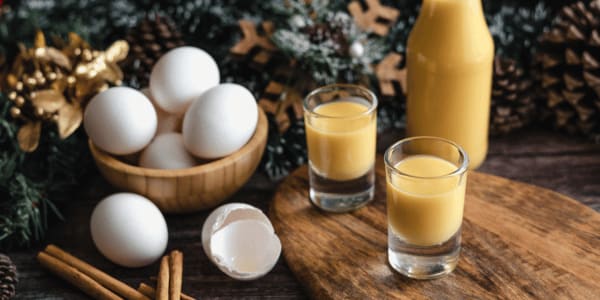What is Eggnog—and Where Did It Even Come From?

A yuletide tradition, eggnog is a sweet and decadent drink that commemorates the holiday season. Revered for its warming effects and heartiness, eggnog has long been appreciated by people of all ages and all walks of life. Join us as we delve into the rich history of eggnog and discover how it became the iconic beverage of good cheer that many enjoy today.
What is Eggnog?
Eggnog is a creamy drink made of eggs, milk, heavy cream, and a variety of spices, like sugar, cinnamon, and nutmeg. Most traditional recipes include alcohol, but it’s not necessary to make some of the best eggnog recipes at home.
Served cold, this delectable beverage is thick and has the consistency of a melted milkshake. With a sweet and milky taste, it’s a filling drink you’re sure to love.
Eggnog Origins
Scholars trace the beginnings of eggnog to a medieval British punch called “posset.” The punch was a mixture of warm milk curdled with alcohol, like wine or beer, and spices. It was used to treat common ailments, such as colds or flus, for people at all levels of society.
Over time, people concocted their own variations of posset. Early records indicate that Medieval European monks added figs and eggs to their posset, which paved the way for the evolution of eggnog.
Evolution of Eggnog
Eggnog was regarded as a drink of the wealthy as early as the 17th century. It was then that British aristocrats used pricy spirits, like sherry and brandy, in their eggnog to toast to health and prosperity.
It eventually made its way to the United States in 1775 when the British brought it over. While milk and eggs were readily available, sherry and brandy were particularly expensive. Instead, many American colonies used rum or other types of alcohol that were more accessible.
The term “eggnog” has no clear origin. However, some believe that “nog” is derived from the word “noggin,” which was a term used to describe a wooden mug made to serve alcohol. Others suggest that “nog” came from the Scottish term nug, which means ale warmed with a hot poker.

Why Do We Drink Eggnog at Christmas?
Back when eggnog first debuted in America in the 18th century, it was served hot and made with a variety of spirits, like brandy, whiskey, or rum.
Because the drink included finer ingredients—eggs, milk, and alcohol—it was generally consumed by the upper class. George Washington was especially fond of the boozy beverage and served it to his guests and family during the holidays. In fact, George Washington’s eggnog recipe is considered the quintessential way to make eggnog.
Thanks to George Washington, drinking eggnog at Christmas caught on, and, love it or hate it, is a tradition that continues today.
RELATED: “8 Holiday Traditions From Around the World That Will Surprise You”
Alcohol vs. Non-Alcoholic Eggnog
The biggest difference between alcoholic and non-alcoholic eggnog is that one includes spirits and the other doesn’t. Non-alcoholic eggnog can be made with a variety of ingredients to suit your tastes. Think coconut milk and fresh juices.
Eggnog with alcohol may include one or more spirits in the recipe. The type of alcohol to use in eggnog might include:
- Brandy/cognac
- Rum
- Bourbon
- Whiskey
- Sherry
- Tequila
- Vodka

How to Make Eggnog: Tips and Tricks
The key to making good eggnog at home is time and patience. Ensure you have ample time to complete all the steps and enough patience to keep yourself from sneaking a glass before it’s ready! Here are more tips and tricks for cooking eggnog at home:
- Use high-quality ingredients. Farm-fresh eggs, whole milk, and heavy cream will offer the best flavor and texture. Bonus if they’re all organic!
- Properly whip the egg yolks and whites. Whisking the egg yolks and sugar correctly creates a smooth and creamy base. Remember to beat the egg whites until they form soft peaks for optimum fluffiness.
- Allow the alcohol to cure the raw eggs. The longer you can let the finished product sit in the fridge, the better. The alcohol cures, or preserves, the eggs, which helps with the flavor and texture. At least five days is recommended.
Healthier Alternatives to Traditional Eggnog Recipes
While traditional eggnog is tasty, it can pack a caloric punch. High in fat, sugar, and alcohol, it’s to be consumed in small doses. Not to mention, it can lead to food poisoning. To make a healthier recipe, consider:
- Using pasteurized egg products. The FDA recommends using liquid or frozen pasteurized egg products or powdered egg whites to prevent foodborne illnesses.
- Substituting alternative milks. Almond milk, coconut milk, or oat milk can provide a similar creamy texture without the high fat content of regular milk.
- Adding natural sweeteners instead of sugar. Honey, agave nectar, and monk fruit are often lower on the glycemic index, yet still deliver a complex sweetness that elevates the taste.
LEARN MORE: “10 Simple Ways to Trick Yourself into Eating Healthier”
Drink Eggnog to Keep the Holiday Spirit Going
Eggnog is the indulgent, creamy drink that we just can’t quit during the holiday season. Made with eggs, milk, cream, sugar, and spices, it warms the heart and brings the magic of the season to life.
To keep spirits bright beyond Christmas, drink a glass of eggnog and read our article on how to keep the holidays merry for just one more month.
